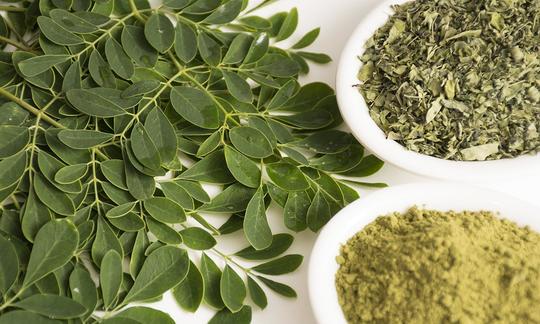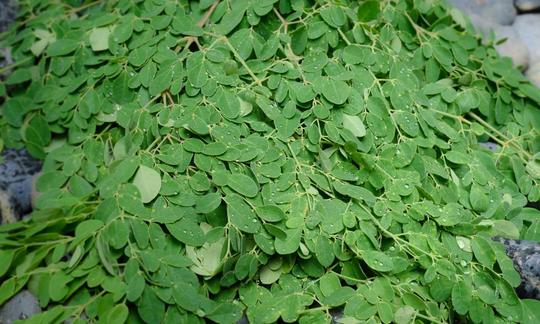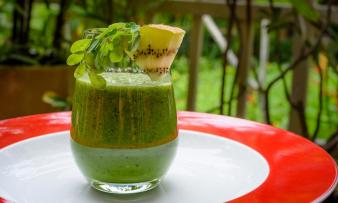Table of contents
The horseradish tree ( Moringa oleifera ) is known as the miracle tree (like other plants) because of its nutrient-rich plant parts. In the countries of origin, the moringa leaves are sometimes eaten raw - more often traditionally cooked to improve the digestibility of the nutrients. 1 organic ?
Using Moringa leaves in the kitchen:
The delicate leaves of the Moringa tree taste like watercress. Traditionally, they are eaten together with the flowers, either cooked as a spinach-like vegetable or fresh as a raw vegetable and salad. 2 When seasoning, the natural salt content (23 mg/100g) 3 should be taken into account. Nutrient-rich and local alternatives for countries in the northern hemisphere are kale , spinach and lamb's lettuce .
How can you eat moringa leaves? Used in moderation, raw moringa tree leaves are a suitable raw food ingredient for smoothies or salads. Finely pureed, the moringa leaf greens (raw) can be used for savory spreads, vegan dips, pestos, sweet creams, desserts, vegan ice cream (nice cream, glace), porridge or couscous salads.
Vegan cooking and baking ideas with fresh moringa leaves are vegetable soups, risotto, curry or tart (alternatively: with dried leaf powder).
Moringa juice, which is extracted from the raw leaves, is a popular addition to drinks in India. In Asia, this juice is consumed as a diet drink to prevent and combat malnutrition.
In the countries of origin, the Moringa pods (Moringa fruit) of the so-called drumstick tree are the more popular vegetable, as the harvesting effort for the Moringa leaf green is relatively high. You can find more information about Moringa in the cooked leaves ( Horseradish tree (Moringa), leaf, cooked ), the Moringa powder or the Moringa pods .
Vegan recipe for pesto with horseradish tree leaves (raw):
Ingredients (for a small jar, approx. 150 ml): 100 g raw moringa leaves (organic), freshly de-stemmed; 25 g raw basil leaves , freshly de-stemmed; 25 g parsley , fresh; 80 g raw walnuts ; 1 tbsp lemon juice , freshly squeezed; 2 raw garlic cloves ; 50 + 25 ml fresh walnut oil ; salt andpepper to taste.
Preparation: Puree herbs, nuts, lemon juice, garlic cloves and 50 ml of oil with a powerful blender until you reach the desired consistency. Season the green pesto with salt and pepper and serve it as fresh as possible. To store the vegan pesto in the fridge, put it in a screw-top jar, cover it with the remaining oil and close it.
Recipe for tea with fresh moringa leaves (raw):
1 tablespoon of fresh (or 0.5 teaspoon of dried) horseradish tree leaves (organic) are poured over with 250 ml of boiling water and the moringa tea is left to steep for about 7-10 minutes. Then pour the infusion through a fine tea strainer and enjoy the tea preparation unsweetened or sweetened (with honey ).
Vegan recipes with Moringa leaves (raw) can be found under the note: " Recipes that have the most of this ingredient ".
| Not only vegans or vegetarians should read this: Vegans often eat unhealthily. Avoidable nutritional mistakes . |
Shopping - where to buy horseradish tree leaves?
Moringa trees are native to the tropics, which is why raw horseradish tree leaves are rarely available outside of their natural range. With a little luck, you can buy fresh moringa leaves in some Indian supermarkets or online. However, the quality of the perishable product may suffer.
Natural food stores, health food stores, organic stores, Asian shops, pharmacies and online shops offer dried moringa leaves as powder, also in raw food quality. You can find the green powder in supermarkets such as Rewe , Spar , Alnatura , Denn's or Coop Vitality . According to our research, supermarket chains such as Migros , Aldi , Lidl , Edeka , Denner , Volg or Hofer do not sell any products with moringa (raw, frozen, juice or even organic).
If you buy dried leaf greens or leaf powder (moringa powder) as a substitute for raw moringa leaves, prefer certified organic quality. Investigations by the Chemical Veterinary and Investigation Office ( CVUA ) in Stuttgart show pesticide residues, salmonella contamination or labeling deficiencies in some moringa products without the organic designation. 4.5
Found in the wild - Moringa leaf season:
Which plant characteristics are used to identify the so-called Behen tree or Behen nut tree? The horseradish tree is a deciduous tree with a pale gray, copper-colored and sometimes bottle-like thickened trunk. It branches out into many protruding, thin and slightly hanging branches. The Moringa roots are thickened like turnips. The 30-60 cm long leaves are pinnate. The individual Moringa leaf is oval and about 1-2 cm long. The fragrant flowers with their five petals are cream-colored and have a diameter of about two and a half centimeters. The flowers can appear in panicles up to 15 cm long. The hanging, about 2 cm wide, ribbed capsules reach a length of 25-50 (sometimes 90) cm. They are bean-like, initially green and later brown. Inside are the seeds, which are up to one and a half centimetres in size, round or almost triangular and each have three paper-like wings. 6
Season: The leaves and flowers of the Moringa plant can be harvested and used fresh at any time. 6
Storing Horseradish Tree Leaves:
Raw, fresh moringa leaves have a shorter shelf life than dried leaf extracts or capsules. Fresh twigs and moringa leaves can be stored in a vase of water for a few days.
Moringa nutritional values - ingredients - calories:
Raw moringa leaves are low in calories with 64 kcal per 100 g. The leaves have a wide range of nutrients, but even 100 g of fresh leaves cannot cover any of these nutrients in the daily requirement. Worth mentioning is the content of vitamin B 6 (pyridoxine) with 1.2 mg/100g, vitamin C (ascorbic acid) with 52 mg/100g and protein with 9.4 g/100g. 3,6,7
The protein-rich, fresh leaves of the Moringa oleifera contain all eight essential amino acids ( tryptophan , threonine , valine , isoleucine , leucine , phenylalanine , lysine , methionine ), with methionine being the limiting factor at 0.12 g/100g. To compensate for this deficit and obtain high-quality protein with a higher bioavailability, it is best to combine the horseradish tree leaves with methionine-rich foods such as raw hemp seeds (0.69 g/100g), raw chia seeds (0.59 g/100g) or raw wheat germ (0.46 g/100g). 3,6,7
Vitamin B 6 : Similar levels to this can be found in wheat bran or wheat germ (1.3 mg/100g). Higher levels can be found in dried herbs (e.g. wild garlic 2.8 mg/100g) and spices or in yeast flakes (2.9 mg/100g). 3.7
Comparable amounts of vitamin C can be obtained from strawberries (59 mg/100g), oranges (53 mg/100g) or snow peas (60 mg/100g). The following raw foods are generous sources of vitamin C, provided they are freshly harvested and have not been stored for long: sea buckthorn berries (450 mg/100g), guavas (228 mg/100g), blackcurrants (181 mg/100g), wild garlic (150 mg/100g) or ground elder (140 mg/100g). 3.7
Moringa oleifera contains varying amounts of flavonoids (quercetin, kaempferol or kaempferol, isorhamnetin). 8 The moringa plant also contains carotenoids, saponins and plant zeatin (plant hormone). 9
The information on nutrients from the USDA database is not always complete and sometimes differs from the figures published in scientific articles. 24 For example, the fresh leaves lack vitamin K and vitamin E, which are present in the cooked leaves . We supplemented the vitamin E content of 100 g of fresh leaves (236 mg) with the help of published studies - the values vary between 25 mg 25 and 448 mg 26 per 100 g depending on the source. We could not find a reliable source for vitamin K (as of April 2022). Therefore, we entered the value (112 mg/100g) ourselves, as it is likely to be similar to that of the cooked version (this vitamin is very heat-stable and is also present in the moringa powder ).
False promises:
Does Moringa contain vitamin B 12 ? Sales websites like to advertise Moringa with an alleged vitamin B 12 content. Traces of real cobalamins can be found in plant-based foods if there has been contamination with bacteria or fermentation. The formation of measurable vitamin B 12 would therefore occur via microorganisms and not via the Moringa plant itself. Since there are strong fluctuations here, these foods are not considered reliable sources of vitamin B 12. They could also possibly be structurally related analogues that do not have any vitamin effectiveness. To date, there is little information on the effectiveness and safety of vitamin B 12 analogues that are formed through nutrient interactions in vitamin and mineral supplements. 3,7,10,11
The way in which the nutritional content of moringa leaves is advertised is designed to deceive consumers. Although the leaves contain a broad spectrum of nutrients, they are not a superfood. 4 Based on current scientific knowledge, no special nutritional benefits are to be expected from moringa in the form of food supplements or other products. 12
The advertising claim that nutrients from (gently dried) moringa leaves are 100% available cannot be proven. Anti-nutritional ingredients such as oxalic acid, trypsin inhibitors (polypeptides) or phytic acid inhibit the absorption of nutrients from (dried) raw preparations. Gently cooking the leaves in water increases the bioavailability of iron and increases the digestibility of protein. 1
Further aspects and nutritional values are discussed in the ingredient Moringa powder .
The complete ingredients of raw Moringa leaves, the coverage of the daily requirement and comparison values with other ingredients can be found in our nutrient tables in CLICK FOR below the ingredients picture.
Health aspects - effects:
Is Moringa really that good? The scientific data for the actual effectiveness of preparations containing Moringa oleifera on human health is poor. Results from basic research and animal studies cannot be transferred one-to-one to humans. 9,13 You can find more detailed information here: Horseradish tree pod ( Moringa oleifera , organic?), raw .
The leaves and seeds of Moringa oleifera have a bactericidal effect. In countries where it occurs naturally, this effect is used to treat drinking water or for physical hygiene - hence the name purifying tree. 14
Dangers - intolerances - side effects:
Possible warnings refer to products made from Moringa roots and leaves of Moringa oleifera : They contain mustard oil glycosides. In very large quantities, tablets, powders, etc. are toxic, which is why the content limits consumption. 4.15
High doses of leaf extracts (> 3000 mg/kg body weight) led to genetic damage in animal experiments (2012). Intake of a maximum of 1000 mg/kg body weight was safe for the test rats. 9,16
Evidence from recent animal studies (2007-2014) shows that the extract from moringa leaves (raw?) in high doses could worsen blood counts, liver and kidney values. Such changes occurred in rats in a laboratory study after 8 weeks. In converted terms, the amount for a 60 kg person corresponds to about 60 g of leaf powder, which would be 250 g of fresh, uncooked leaves (daily). 17,18,19
It is still unclear whether and to what extent these findings can be transferred to humans. Only well-conducted studies with humans can provide information here. 13
Interactions may occur if Moringa oleifera capsules are taken at the same time as medication (immunomodulators, anti-hormone therapy). In cancer patients, ingredients in Moringa can inhibit the liver's cytochrome P450 enzyme type 3A4. In these cases, use should be discussed with the treating doctor. 20
Folk medicine - naturopathy:
All parts of the Moringa tree are used in the local, traditional medicine of India, Sri Lanka, Java and Africa.
Young moringa leaves are used in traditional medicine to stimulate milk flow. Other traditional uses for internal treatment include tuberculosis, asthma, gout, rheumatism, enlarged spleen or liver, gallstones and kidney stones. 6
Occurrence - origin - ecology:
Moringa is an important cultivated plant in India, Ethiopia, the Philippines and Sudan. Moringa oleifera is the most economically valuable species and comes from South Asia, where it grows in the foothills of the Himalayas. The plant is now widespread in the tropics. Nine varieties are found in eastern Ethiopia, northern Kenya and Somalia, eight of which are endemic to Africa. 22
Growing in the garden or as a potted plant:
Is Moringa hardy? In temperate regions, Moringa thrives as a potted plant in the room or winter garden. In summer, the Moringa tree can be kept frost-free on the terrace or balcony at minimum temperatures of 15-18 °C. 6,21 Moringa does not tolerate waterlogging. 22
Cultivation - Harvesting Horseradish Tree Leaves:
Moringa oleifera is the most commonly cultivated species in the Moringa genus. The main growing areas of the Moringa tree include South India, Thailand, the Philippines, Honduras and South America. With an annual production of 1.1-1.3 million tons of fruits from an area of 380 m 2 , India is the largest producer of Moringa products. 23
Ecological aspects:
The tree ( Moringa oleifera ) is used to harsh conditions and requires little water. Moringa species are therefore used to reforest the Sudanese Sahel zone. 8 Moringa trees cause windbreaks and reduce soil erosion. 22 Cultivation in Honduras is intended to counteract deforestation.
Moringa is fast-growing and drought tolerant. During dry seasons and times of drought, the plant produces leaves that are an excellent source of green vegetables when food is scarce. 22
Danger of confusion:
Moringa oleifera is colloquially known as the 'miracle tree'. It shares this name with other plants. This can lead to confusion due to ambiguous names, e.g. with castor oil plant. You can find distinguishing features HERE under the subtitle of the same name.
General information about Moringa:
The horseradish tree ( Moringa oleifera , syn.: Guilandina moringa ) belongs to the Moringaceae family. The plant is not related to horseradish ( Armoracia rusticana ). The German name horseradish tree is derived from the content of mustard oil glycosides, which are responsible for the pungent, burning smell of the Moringa root and are reminiscent of horseradish. The aromatic root of the Moringa is used peeled (poisonous alkaloids in the outer layer) and is also known under the name Moringa spice.
Behen oil (moringa oil, horseradish tree oil) is produced from the seeds.
Alternative names for Moringa:
The common name for Moringa in German is horseradish tree (horseradish tree). Other alternative names for Moringa oleifera (incorrect spellings moringa olifera , oleifa ) are: miracle tree (miracle tree), Moringa miracle tree (incorrect: miracle tree moringa), Indian miracle tree (not African miracle tree!), purifying agent tree, drumstick tree, horse radish tree or behen tree or behen nut tree. The term ben nut tree often refers to the related species Moringa peregrina (true ben nut tree).
The term horseradish leaves (horseradish leaf) is often used as an abbreviation for horseradish tree leaves.
In English, the Moringa tree is called drumstick tree, horseradish tree or ben tree (also: ben oil tree, benzolive tree or reseda). The Moringa tree leaf or the Moringa leaves (horseradish leaves) are called drumstick leaves or moringa tree leaves in English.
Local names are Murungai, Murunga and Malunggay. In Spanish, Moringa leaves are called hojas de moringa, and the dried leaf is called hoja seca de moringa.
Literature - Sources:











Comments